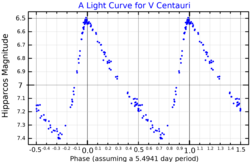| Observation data Epoch J2000 Equinox J2000 | |
|---|---|
| Constellation | Centaurus |
| Right ascension | 14h 32m 33.0833s [2] |
| Declination | −56° 53′ 15.774″ [2] |
| Apparent magnitude (V) | 6.42 - 7.22 [3] |
| Characteristics | |
| Spectral type | F5 Ib/II [4] |
| B−V color index | 0.87 [5] |
| Variable type | Classical Cepheid [3] |
| Astrometry | |
| Radial velocity (Rv) | −18.90 ± 1.4 [6] km/s |
| Proper motion (μ) |
RA: −6.697
[2]
mas/
yr Dec.: −7.068 [2] mas/ yr |
| Parallax (π) | 1.3898 ± 0.0221 mas [2] |
| Distance | 2,350 ± 40
ly (720 ± 10 pc) |
| Details | |
| Mass | 4.3 [7] M☉ |
| Radius | 40 [2] R☉ |
| Luminosity | 1,657 [8] L☉ |
| Surface gravity (log g) | 1.89 [2] cgs |
| Temperature | 5,500 [8] K |
| Metallicity [Fe/H] | +0.12 [9] dex |
| Age | 103 [10] Myr |
| Other designations | |
| Database references | |
| SIMBAD | data |
V Centauri (V Cen) is a Classical Cepheid variable, a type of variable star, in the constellation Centaurus. It is approximately 2,350 light-years (720 parsecs) away based on parallax.
V Centauri varies regularly between visual magnitudes 4.2 and 7.2 every 5.5 days. It is classified as a Cepheid variable on the basis of its light variations, with the brightness increase from minimum to maximum taking only a third of the time of the decrease from maximum to minimum. Cepheids are pulsating variable stars and V Centauri expands and contracts over its pulsation cycle as well as changing temperature. [3]
According to the South African Astronomical Observatory, the chemical composition was derived as being high in sodium (Na) and aluminium (Al) and low in magnesium (Mg). [11] Following a normal composition for a Cepheid star, V Cen does not have any unusual characteristics. V Centauri's composition was observed alongside six other Classical Cepheid variable stars with the support of Russian, Chilean, and Ukrainian observatories. [11]
References
- ^ "Hipparcos Tools Interactive Data Access". Hipparcos. ESA. Retrieved 8 December 2021.
- ^ a b c d e f g Vallenari, A.; et al. (Gaia collaboration) (2023). "Gaia Data Release 3. Summary of the content and survey properties". Astronomy and Astrophysics. 674: A1. arXiv: 2208.00211. Bibcode: 2023A&A...674A...1G. doi: 10.1051/0004-6361/202243940. S2CID 244398875. Gaia DR3 record for this source at VizieR.
- ^ a b c Samus, N. N.; Durlevich, O. V.; et al. (2009). "VizieR Online Data Catalog: General Catalogue of Variable Stars (Samus+ 2007-2013)". VizieR On-line Data Catalog: B/GCVS. Originally Published in: 2009yCat....102025S. 1: B/gcvs. Bibcode: 2009yCat....102025S.
- ^ Houk, N.; Cowley, A. P. (1975). "University of Michigan Catalogue of two-dimensional spectral types for the HD stars. Volume I. Declinations -90°.0 to -53°.0". Michigan Catalogue of Two-dimensional Spectral Types for the HD Stars. 1. Bibcode: 1975mcts.book.....H.
- ^ a b "V* V Cen". SIMBAD. Centre de données astronomiques de Strasbourg.
- ^ Gontcharov, G. A. (2006). "Pulkovo Compilation of Radial Velocities for 35 495 Hipparcos stars in a common system". Astronomy Letters. 32 (11): 759–771. arXiv: 1606.08053. Bibcode: 2006AstL...32..759G. doi: 10.1134/S1063773706110065. S2CID 119231169.
- ^ Marconi, Marcella; et al. (July 2020). "Predicted Masses of Galactic Cepheids in the Gaia Data Release 2". The Astrophysical Journal Letters. 898 (1): L7. arXiv: 2006.16610. Bibcode: 2020ApJ...898L...7M. doi: 10.3847/2041-8213/aba12b. S2CID 220265392. L7.
- ^ a b Groenewegen, M. A. T. (2020). "Analysing the spectral energy distributions of Galactic classical Cepheids". Astronomy and Astrophysics. 635: A33. arXiv: 2002.02186. Bibcode: 2020A&A...635A..33G. doi: 10.1051/0004-6361/201937060. S2CID 211043995.
- ^ Ripepi, V.; Catanzaro, G.; Clementini, G.; De Somma, G.; Drimmel, R.; Leccia, S.; Marconi, M.; Molinaro, R.; Musella, I.; Poggio, E. (2022). "Classical Cepheid period-Wesenheit-metallicity relation in the Gaia bands". Astronomy and Astrophysics. 659: A167. arXiv: 2201.01126. Bibcode: 2022A&A...659A.167R. doi: 10.1051/0004-6361/202142649. S2CID 245668845.
- ^ Skowron, D. M.; Skowron, J.; Mróz, P.; Udalski, A.; Pietrukowicz, P.; Soszyński, I.; Szymański, M. K.; Poleski, R.; Kozłowski, S.; Ulaczyk, K.; Rybicki, K.; Iwanek, P.; . Wrona, M.; Gromadzki, M. (2019). "Mapping the Northern Galactic Disk Warp with Classical Cepheids". Acta Astronomica. 69 (4): 305. arXiv: 1912.11142. Bibcode: 2019AcA....69..305S. doi: 10.32023/0001-5237/69.4.1. S2CID 209460868.
- ^ a b Usenko, I. A.; Kniazev, A. Yu; Berdnikov, L. N.; Kravtsov, V. V.; Fokin, A. B. (2013-07-01). "Spectroscopic studies of southern-hemisphere Cepheids: Six objects in Centaurus (V Cen, V737 Cen) and Sagittarius (BB Sgr, W Sgr, X Sgr, Y Sgr)". Astronomy Letters. 39 (7): 432–445. Bibcode: 2013AstL...39..432U. doi: 10.1134/S1063773713070074. ISSN 1063-7737. S2CID 121213614.
